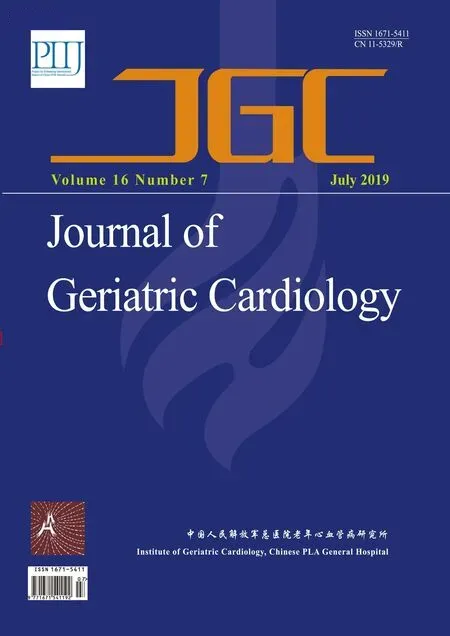A 99-year old patient with takotsubo cardiomyopathy recovering from cardiogenic shock
Mustafa Yener?a?, U?ur Arslan, Güney Erdo?an, Onur Osman ?eker, Osman Can Yontar
Department of Cardiology, University of Health Sciences Samsun Training and Research Hospital, Samsun, Turkey
Keywords: Apical ballooning; Levosimendan; Takotsubo cardiomyopathy
Takotsubo syndrome (TTS) is a rare clinical entity commonly seen in post-menopausal women after an emotional or sometimes physical stress.[1,2]This syndrome is thought to be caused by increased circulation catecholamine levels secondary to an adrenergic stimulus resulting in transient coronary spasm and microvascular dysfunction.[3]TTS is characterized by acute and reversible left ventricular dysfunction with the typical ECG and clinical findings of an acute coronary syndrome but no significant coronary stenosis.[4]Typically, in TTS, antero-apical ballooning is observed in ventriculography, and segmentary wall motion abnormalities are observed in magnetic resonance imaging and echocardiography. Acute heart failure, left ventricular outflow tract obstruction, mitral regurgitation and cardiogenic shock may complicate this syndrome.[5]Herein, we present a case who is the oldest one in the literature with TTS and cardiogenic shock.
A 99-year old female patient known to have Alzheimer's disease admitted to our emergency department with the complaints of acute severe chest pain and dyspnea. She had the signs of acute heart failure with a blood pressure of 70/50 mmHg. In her ECG, ST segment elevation in derivations V2-V6 and D2-D3-aVF, and ST segment depression in V1 and AVR were present (Figure 1). Troponin I level measured at admission was 13 μg/L. Coronary angiography was performed immediately revealing no significant coronary artery disease (Video 1). In the ventriculogram, apical and mid-ventricular ballooning with basal hyperkinesia, typically observed in TTS, was demonstrated (Figure 2, Video 2). In the echocardiography, depressed left ventricular ejection fraction (30%), akinesia and dilatation of the mid and apical portions of left ventricle were seen without an obstruction in the outflow tract (Video 3). Concerning with the diagnosis of TTS and cardiogenic shock, 0, 1 μg/kg per minute. Levosimendan infusion for 72 h, acetylsalicylic acid (81 mg), clopidogrel (75 mg), enoxaparin (0.4 mL bid s.c.) and diuretic treatments were started. She was stabilized hemodynamically 12 h after, and at the 10thday, echocardiography was repeated and recovery of the ejection fraction to 50% with mild apical hypokinesia was found. She was discharged with acetylsalicylic acid (81 mg), clopidogrel (75 mg), and furosemide (40 mg) thereafter.

Figure 1. ECG at admission.

Figure 2. Apical ballooning image at ventriculography.
TTS is observed in > 55 year women 5 times more than the < 55 year women and 10 times more than the men.[5]This disease is estimated to be detected in 5%-6% of female patients with suspicion of ST elevation myocardial infarction and 1%-3% of female patients with acute coronary syndrome.[6,7]In 2015, Budnik, et al.[8]reported the oldest patient with TTS (98 years-old). Now, our 99-year old patient has become the oldest TTS patient reported in the literature.
Treatment strategies of TTS depend on the expert consensus and clinical experience, because no randomized clinical study of this disease is not present.[5]Main aims of treatment include regression of the cardiac symptoms and early recovery of cardiac functions. Cardiogenic shock develops in 6%–20% of TTS patients and positive inotropic agents may be needed in those patients with shock. However, 20% mortality was reported in patients taking catecholaminergic drugs,[9]because increased catecholamine levels play a major role in the pathogenesis of this syndrome. Recently, a calcium channel sensitizer, levosimendan use has been reported to be an alternative to catecholaminergic drugs.[10]Yaman, et al.[11]reported that continuous i.v. levosimendan administration with loading dose can improve ejection fraction more rapidly and reduce hospital stay safely and efficiently. In this case, we used levosimendan as an inotropic agent and recovery from cardiogenic shock was observed in such an old patient.
In conclusion, TTS is a rare disease which may be observed in patients with the clinics of acute coronary syndrome especially in older female patients. Our case is unique with her age which was the highest in literature and recovered well from cardiogenic shock after levosimendan infusion.
Acknowledgements
The authors declared no conflict of interest.
 Journal of Geriatric Cardiology2019年7期
Journal of Geriatric Cardiology2019年7期
- Journal of Geriatric Cardiology的其它文章
- Supplementary Materials
- Thoracic aorta thickness and histological changes with aging: an experimental rat model
- A first attempt of inferior vena cava filter successfully guided by a mixed-reality system: a case report
- Approach to a patient with cardiac amyloidosis
- Adverse reactions of Amiodarone
- Effects of febuxostat on atrial remodeling in a rabbit model of atrial fibrillation induced by rapid atrial pacing
